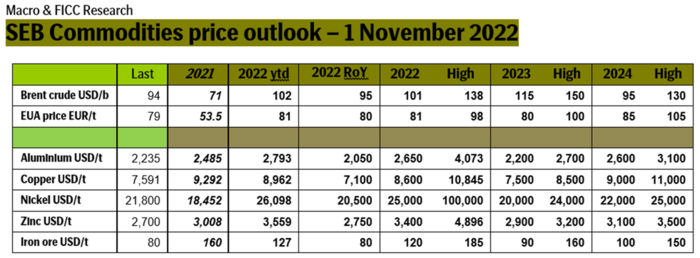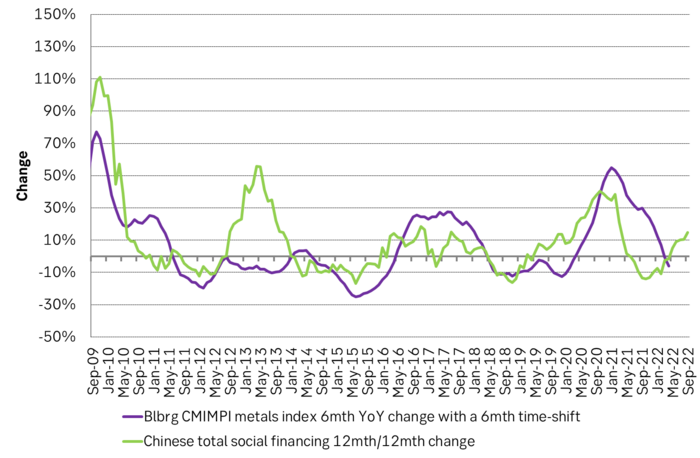Analys
Metals price forecast: Lower Before Higher

Lower before higher

The world is slowing down along with fiscal and monetary tightening. The rapid rise in interest rates this year will work with a lag so the slowdown in the real economy is likely to continue. We expect metals prices to ease along with that. The continued deterioration in the Chinese property market is likely structural with growth shifting towards higher value sectors including green energy and EVs. Chinese credit expansion has started. Stronger demand for metals like copper, nickel and aluminium is likely to emerge in H2-23. Strong prices for metals over the coming decade due to sub-par capex spending over the past decade is likely.

Weakening macro and weakening demand. The world is now in the grip of a tightening craze amid inflation panic which was the result of the stimulus boom ignited by Covid-19 panic. The US expanded its M2 monetary base by 30% of GDP during the stimulus boom. Donald Trump earlier clamped down on immigration from Mexico/Latin America. Rampant consumer spending on capital goods together with an ultra-tight labor market then led to intense inflation pressure in the US. But also, in many other countries which also stimulated too much. The US is ahead of the curve with respect to interest rate hikes. The USD has rallied, forcing many central banks around the world to lift rates to defend their currencies as well as fighting their own inflationary pressures. The Japanese central bank has refrained from doing so and has instead intervened in the yen currency market for the first time since 1998. The year 2022 will likely be the worst selloff in global government bonds since 1949 as interest rates rise rapidly from very low levels. This is taking place following a decade where the world has been gorging on ultra-cheap debt. There is clearly a risk that something will break apart somewhere in the financial system as the world gallops through this extreme roller coaster ride of stimulus and tightening. On top of this we have and energy crisis in Europe where natural gas prices for year 2023 currently is priced at 700% of normal levels. War in Ukraine, risk for the use of nuclear weapons, an enduring cool-down of the Chinese property market and continued lock-downs in China due to Covid-19 is adding plenty of uncertain elements.
Downside price risks for metals over the coming 6-9 months. The significant rise in rates around the world will work with a lag. There can be up to a 12-month lag from rates starts to rise to when they take real effect. Continued economic cool-down in the economy is thus likely. Chinese politicians seem unlikely to run yet another round of property market-based stimulus. As such there are clearly downside risks to global economic growth and industrial metals prices over the coming 6 months.
China may be a “White Swan Event” in H2-23 onward. LME’s China seminar in London on Monday 24 October this year was very interesting. The brightest spot in our view was Jinny Yang, the Chief China economist at ICBC Standard Bank. She stated that China may turn out to be a “white swan event” in H2-2023. Further that the Chinese economy now is on a decade long type of transition period. Away from property focused growth. With a shift instead to technology and innovation, telecoms and energy transition, consumer demand side economy and higher value and more advanced sectors. The property market will be a fading sector with respect to growth. Chinese politicians are fully committed to the energy transition. No slowdown in there. Credit expansion has already started. The real effect of that will emerge in H2-23. The new growth focus will be different from before. But it will still imply lots of metals like aluminium, copper, nickel, zinc, cobalt, manganese, and other special metals. There will be less copper for pipes and wiring for housing but there will be more copper for EVs, Solar power, Wind power and power networks etc.
Copper: Struggling supply from Chile, rising supply from Africa while Russian exports keeps flowing to market. The Chinese housing market normally accounts for 20% of global copper demand. So, slowing Chinese housing market is bad for copper. Russian exports keep flowing to SE Asia where it is re-exported. Good supply growth is expected from Africa in 2023. Supply from Chile is struggling with falling ore grades, political headwinds, and mining strikes. Demand is projected to boom over the coming decades while investments in new mines have been sub-par over the past decade. So strong prices in the medium to longer term. But in the short-term the negative demand forces will likely have the upper hand.
Nickel: Tight high-quality nickel market but surplus for low-quality nickel. There is currently a plentiful supply of low-grade nickel with weak stainless-steel demand and strong demand for high quality nickel for EV batteries. The result is a current USD 5-6000/ton price premium for high-quality vs. low-quality nickel. High-quality LME grade nickel now only accounts for 25% of the global nickel market. Over the coming decade there will be strong demand growth for high-quality nickel for EV batteries, but high-quality NiSO4 will take center stage. The price of high-quality nickel over the coming decade will depend on how quickly the world can ramp up low-grade to high-grade conversion capacity.
Aluminium: Russian production and exports keeps flowing at normal pace to the market through different routes. Supply from the western world set to expand by 1.3 m ton pa in 2023, the biggest expansion in a decade. Demand is projected to grow strongly over the decade to come with energy transition and EVs being strong sources of demand. Western premiums likely to stay elevated versus Asian premiums to attract metal. Increasing focus on low carbon aluminium. But weakness before strength.
SEB commodities price forecast:

Chinese credit cycle vs industrial metals. Chinese credit expansion has already started.

This report has been compiled by SEB´s Commodity Research, a division within Skandinaviska Enskilda Banken AB (publ) (”SEB”), to provide background information only.
Analys
Tightening fundamentals – bullish inventories from DOE

The latest weekly report from the US DOE showed a substantial drawdown across key petroleum categories, adding more upside potential to the fundamental picture.

Commercial crude inventories (excl. SPR) fell by 5.8 million barrels, bringing total inventories down to 415.1 million barrels. Now sitting 11% below the five-year seasonal norm and placed in the lowest 2015-2022 range (see picture below).
Product inventories also tightened further last week. Gasoline inventories declined by 2.1 million barrels, with reductions seen in both finished gasoline and blending components. Current gasoline levels are about 3% below the five-year average for this time of year.
Among products, the most notable move came in diesel, where inventories dropped by almost 4.1 million barrels, deepening the deficit to around 20% below seasonal norms – continuing to underscore the persistent supply tightness in diesel markets.
The only area of inventory growth was in propane/propylene, which posted a significant 5.1-million-barrel build and now stands 9% above the five-year average.
Total commercial petroleum inventories (crude plus refined products) declined by 4.2 million barrels on the week, reinforcing the overall tightening of US crude and products.


Analys
Bombs to ”ceasefire” in hours – Brent below $70

A classic case of “buy the rumor, sell the news” played out in oil markets, as Brent crude has dropped sharply – down nearly USD 10 per barrel since yesterday evening – following Iran’s retaliatory strike on a U.S. air base in Qatar. The immediate reaction was: “That was it?” The strike followed a carefully calibrated, non-escalatory playbook, avoiding direct threats to energy infrastructure or disruption of shipping through the Strait of Hormuz – thus calming worst-case fears.

After Monday morning’s sharp spike to USD 81.4 per barrel, triggered by the U.S. bombing of Iranian nuclear facilities, oil prices drifted sideways in anticipation of a potential Iranian response. That response came with advance warning and caused limited physical damage. Early this morning, both the U.S. President and Iranian state media announced a ceasefire, effectively placing a lid on the immediate conflict risk – at least for now.
As a result, Brent crude has now fallen by a total of USD 12 from Monday’s peak, currently trading around USD 69 per barrel.
Looking beyond geopolitics, the market will now shift its focus to the upcoming OPEC+ meeting in early July. Saudi Arabia’s decision to increase output earlier this year – despite falling prices – has drawn renewed attention considering recent developments. Some suggest this was a response to U.S. pressure to offset potential Iranian supply losses.
However, consensus is that the move was driven more by internal OPEC+ dynamics. After years of curbing production to support prices, Riyadh had grown frustrated with quota-busting by several members (notably Kazakhstan). With Saudi Arabia cutting up to 2 million barrels per day – roughly 2% of global supply – returns were diminishing, and the risk of losing market share was rising. The production increase is widely seen as an effort to reassert leadership and restore discipline within the group.
That said, the FT recently stated that, the Saudis remain wary of past missteps. In 2018, Riyadh ramped up output at Trump’s request ahead of Iran sanctions, only to see prices collapse when the U.S. granted broad waivers – triggering oversupply. Officials have reportedly made it clear they don’t intend to repeat that mistake.
The recent visit by President Trump to Saudi Arabia, which included agreements on AI, defense, and nuclear cooperation, suggests a broader strategic alignment. This has fueled speculation about a quiet “pump-for-politics” deal behind recent production moves.
Looking ahead, oil prices have now retraced the entire rally sparked by the June 13 Israel–Iran escalation. This retreat provides more political and policy space for both the U.S. and Saudi Arabia. Specifically, it makes it easier for Riyadh to scale back its three recent production hikes of 411,000 barrels each, potentially returning to more moderate increases of 137,000 barrels for August and September.
In short: with no major loss of Iranian supply to the market, OPEC+ – led by Saudi Arabia – no longer needs to compensate for a disruption that hasn’t materialized, especially not to please the U.S. at the cost of its own market strategy. As the Saudis themselves have signaled, they are unlikely to repeat previous mistakes.
Conclusion: With Brent now in the high USD 60s, buying oil looks fundamentally justified. The geopolitical premium has deflated, but tensions between Israel and Iran remain unresolved – and the risk of missteps and renewed escalation still lingers. In fact, even this morning, reports have emerged of renewed missile fire despite the declared “truce.” The path forward may be calmer – but it is far from stable.
Analys
A muted price reaction. Market looks relaxed, but it is still on edge waiting for what Iran will do

Brent crossed the 80-line this morning but quickly fell back assigning limited probability for Iran choosing to close the Strait of Hormuz. Brent traded in a range of USD 70.56 – 79.04/b last week as the market fluctuated between ”Iran wants a deal” and ”US is about to attack Iran”. At the end of the week though, Donald Trump managed to convince markets (and probably also Iran) that he would make a decision within two weeks. I.e. no imminent attack. Previously when when he has talked about ”making a decision within two weeks” he has often ended up doing nothing in the end. The oil market relaxed as a result and the week ended at USD 77.01/b which is just USD 6/b above the year to date average of USD 71/b.

Brent jumped to USD 81.4/b this morning, the highest since mid-January, but then quickly fell back to a current price of USD 78.2/b which is only up 1.5% versus the close on Friday. As such the market is pricing a fairly low probability that Iran will actually close the Strait of Hormuz. Probably because it will hurt Iranian oil exports as well as the global oil market.
It was however all smoke and mirrors. Deception. The US attacked Iran on Saturday. The attack involved 125 warplanes, submarines and surface warships and 14 bunker buster bombs were dropped on Iranian nuclear sites including Fordow, Natanz and Isfahan. In response the Iranian Parliament voted in support of closing the Strait of Hormuz where some 17 mb of crude and products is transported to the global market every day plus significant volumes of LNG. This is however merely an advise to the Supreme leader Ayatollah Ali Khamenei and the Supreme National Security Council which sits with the final and actual decision.
No supply of oil is lost yet. It is about the risk of Iran closing the Strait of Hormuz or not. So far not a single drop of oil supply has been lost to the global market. The price at the moment is all about the assessed risk of loss of supply. Will Iran choose to choke of the Strait of Hormuz or not? That is the big question. It would be painful for US consumers, for Donald Trump’s voter base, for the global economy but also for Iran and its population which relies on oil exports and income from selling oil out of that Strait as well. As such it is not a no-brainer choice for Iran to close the Strait for oil exports. And looking at the il price this morning it is clear that the oil market doesn’t assign a very high probability of it happening. It is however probably well within the capability of Iran to close the Strait off with rockets, mines, air-drones and possibly sea-drones. Just look at how Ukraine has been able to control and damage the Russian Black Sea fleet.
What to do about the highly enriched uranium which has gone missing? While the US and Israel can celebrate their destruction of Iranian nuclear facilities they are also scratching their heads over what to do with the lost Iranian nuclear material. Iran had 408 kg of highly enriched uranium (IAEA). Almost weapons grade. Enough for some 10 nuclear warheads. It seems to have been transported out of Fordow before the attack this weekend.
The market is still on edge. USD 80-something/b seems sensible while we wait. The oil market reaction to this weekend’s events is very muted so far. The market is still on edge awaiting what Iran will do. Because Iran will do something. But what and when? An oil price of 80-something seems like a sensible level until something do happen.
-

 Nyheter4 veckor sedan
Nyheter4 veckor sedanUppgången i oljepriset planade ut under helgen
-

 Nyheter3 veckor sedan
Nyheter3 veckor sedanMahvie Minerals växlar spår – satsar fullt ut på guld
-

 Nyheter4 veckor sedan
Nyheter4 veckor sedanLåga elpriser i sommar – men mellersta Sverige får en ökning
-

 Nyheter2 veckor sedan
Nyheter2 veckor sedanOljan, guldet och marknadens oroande tystnad
-

 Nyheter2 veckor sedan
Nyheter2 veckor sedanJonas Lindvall är tillbaka med ett nytt oljebolag, Perthro, som ska börsnoteras
-

 Analys4 veckor sedan
Analys4 veckor sedanVery relaxed at USD 75/b. Risk barometer will likely fluctuate to higher levels with Brent into the 80ies or higher coming 2-3 weeks
-

 Analys3 veckor sedan
Analys3 veckor sedanA muted price reaction. Market looks relaxed, but it is still on edge waiting for what Iran will do
-

 Nyheter2 veckor sedan
Nyheter2 veckor sedanDomstolen ger klartecken till Lappland Guldprospektering











